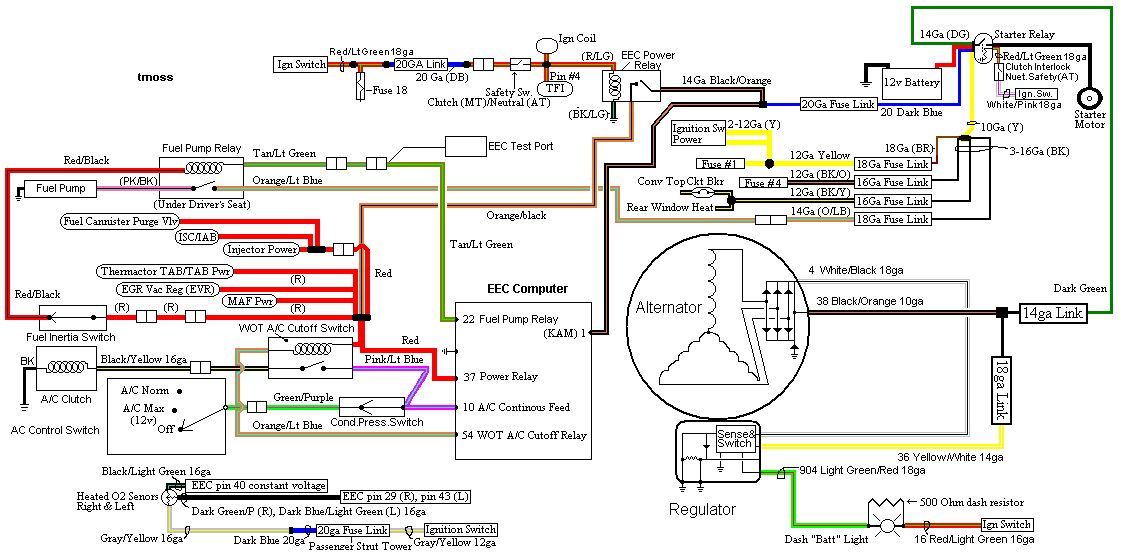I just got through doing a number of things to get rid of alot of annoying idle and throttle issues, and the car is driving great. The idle is nice, it comes down quickly, and surge is almost completely gone. I am getting a check engine light when letting off of the throttle under load. It doesn't have to be at redline, even when letting off of the gas after flooring it in third or fourth will cause a check engine light to come on, and then go off after a few seconds.
I'll try to keep this short.
I did the following:
- base idle reset, set it low and used the bypass plate to get rid of the surge
- reset the tps
- redid the computer grounds
- cleaned the 10-pin connectors
I have a number of codes, but believe that I have always had them:
KOEO
15 - EEC, probably because of the chip
67 - neutral drive switch, circuit failure
Memory
66 - VAF/MAF sensor fault, below minimum voltage - probably because of the tune?
87 - Fuel pump primary circuit failure
96 - Fuel pump secondary circuit fault/high speed fuel pump relay open
I know that Joel had a nice video about how the neutral safety switch can cause surging, need to research that further.
The MAF one I think is because of the tune, alot of MAF tuning to get the 60 lb injectors working right.
The fuel pump ones might be related to the Kenne Bell boost-a-pump, not sure.
But, here's where I think I might have messed up. I had hidden my wires last year, and recently 'fixed' my grounds. I ran another 1/O ground cable from the battery to the tranny, and extended the computer ground wire to connect to that same place to make sure that I didn't have an iffy connection using a sheetmetal location under the fender liner. But, I wonder if splicing in and extending it will cause it to have trouble.
Due to ignorance, I thought the connector on it was an inline fuse, but of course it isn't. I was trying to avoid having that connector inside of the fender liner in case I needed to replace it, so I extended the wire to get the connector out in the open. I know my splicing technique is good, because I have done tests with my voltmeter to make sure that I don't lose any current. I also noticed that this wire seemed like it was just standard, stranded wire.
Please see pic belowfor where I spliced it and soldered in an extension.
Will this cause the engine to throw a code? Even though there are a number of codes above, I believe I always had them and didn't have the check engine light. The only real change after last weekend is related to the gounds. But, another ground cable isn't likely to cause any problem. Extending the computer ground might. ???
View attachment 258740
I'll try to keep this short.
I did the following:
- base idle reset, set it low and used the bypass plate to get rid of the surge
- reset the tps
- redid the computer grounds
- cleaned the 10-pin connectors
I have a number of codes, but believe that I have always had them:
KOEO
15 - EEC, probably because of the chip
67 - neutral drive switch, circuit failure
Memory
66 - VAF/MAF sensor fault, below minimum voltage - probably because of the tune?
87 - Fuel pump primary circuit failure
96 - Fuel pump secondary circuit fault/high speed fuel pump relay open
I know that Joel had a nice video about how the neutral safety switch can cause surging, need to research that further.
The MAF one I think is because of the tune, alot of MAF tuning to get the 60 lb injectors working right.
The fuel pump ones might be related to the Kenne Bell boost-a-pump, not sure.
But, here's where I think I might have messed up. I had hidden my wires last year, and recently 'fixed' my grounds. I ran another 1/O ground cable from the battery to the tranny, and extended the computer ground wire to connect to that same place to make sure that I didn't have an iffy connection using a sheetmetal location under the fender liner. But, I wonder if splicing in and extending it will cause it to have trouble.
Due to ignorance, I thought the connector on it was an inline fuse, but of course it isn't. I was trying to avoid having that connector inside of the fender liner in case I needed to replace it, so I extended the wire to get the connector out in the open. I know my splicing technique is good, because I have done tests with my voltmeter to make sure that I don't lose any current. I also noticed that this wire seemed like it was just standard, stranded wire.
Please see pic belowfor where I spliced it and soldered in an extension.
Will this cause the engine to throw a code? Even though there are a number of codes above, I believe I always had them and didn't have the check engine light. The only real change after last weekend is related to the gounds. But, another ground cable isn't likely to cause any problem. Extending the computer ground might. ???
View attachment 258740

